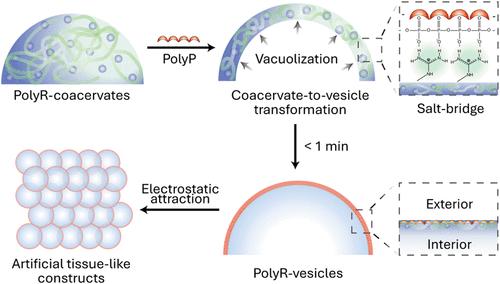盐桥介导的富含精氨酸的凝聚体向囊泡的转化
IF 16
1区 材料科学
Q1 CHEMISTRY, MULTIDISCIPLINARY
引用次数: 0
摘要
多肽基液-液相分离(LLPS)由于控制着细胞中无膜细胞器的形成而受到广泛关注。然而,关于蛋白质中最常见的阳离子氨基酸之一精氨酸如何与各种生物分子相互作用以诱导相分离并进行形态发生的详细机制理解仍有待解决。本文报道了引入多磷酸盐后富精氨酸凝聚物的相分离行为和向囊泡结构的转变。向囊泡的转化独立于最初的阴离子对偶物,是由精氨酸残基的胍基和磷酸盐之间的盐桥相互作用驱动的。我们还研究了分子间力和离子效应在形态转化中的作用,并进一步开发了它们在人工组织样结构组装中的潜力。总的来说,我们的研究结果为富精氨酸凝聚体的囊泡转化及其重建分层生物微室的潜力提供了统一的原则。本文章由计算机程序翻译,如有差异,请以英文原文为准。

Salt-Bridge-Mediated Coacervate-to-Vesicle Transformation in Arginine-Rich Coacervates
Polypeptide-based liquid–liquid phase separation (LLPS) has received considerable attention as it governs the formation of membraneless organelles in cells. However, the detailed mechanistic understanding of how one of the most prevalent cationic amino acids in proteins, arginine, interacts with various biomolecules to induce phase separation and undergo morphogenesis remains to be resolved. Herein, we report the phase separation behavior and transformation of arginine-rich coacervates into vesicular structures upon introducing polyphosphates. Transformation into vesicles was shown to occur independent of the initial anionic counterparts and was driven by salt-bridge interactions between guanidinium groups of arginine residues and phosphates. We also investigate the role of intermolecular forces and ionic effects on the morphological transformation and further exploit their potential in the assembly of artificial tissue-like constructs. Overall, our findings underpin a unifying principle for vesicle transformation from arginine-rich coacervates and their potency for reconstituting hierarchical biological microcompartments.
求助全文
通过发布文献求助,成功后即可免费获取论文全文。
去求助
来源期刊

ACS Nano
工程技术-材料科学:综合
CiteScore
26.00
自引率
4.10%
发文量
1627
审稿时长
1.7 months
期刊介绍:
ACS Nano, published monthly, serves as an international forum for comprehensive articles on nanoscience and nanotechnology research at the intersections of chemistry, biology, materials science, physics, and engineering. The journal fosters communication among scientists in these communities, facilitating collaboration, new research opportunities, and advancements through discoveries. ACS Nano covers synthesis, assembly, characterization, theory, and simulation of nanostructures, nanobiotechnology, nanofabrication, methods and tools for nanoscience and nanotechnology, and self- and directed-assembly. Alongside original research articles, it offers thorough reviews, perspectives on cutting-edge research, and discussions envisioning the future of nanoscience and nanotechnology.
 求助内容:
求助内容: 应助结果提醒方式:
应助结果提醒方式:


